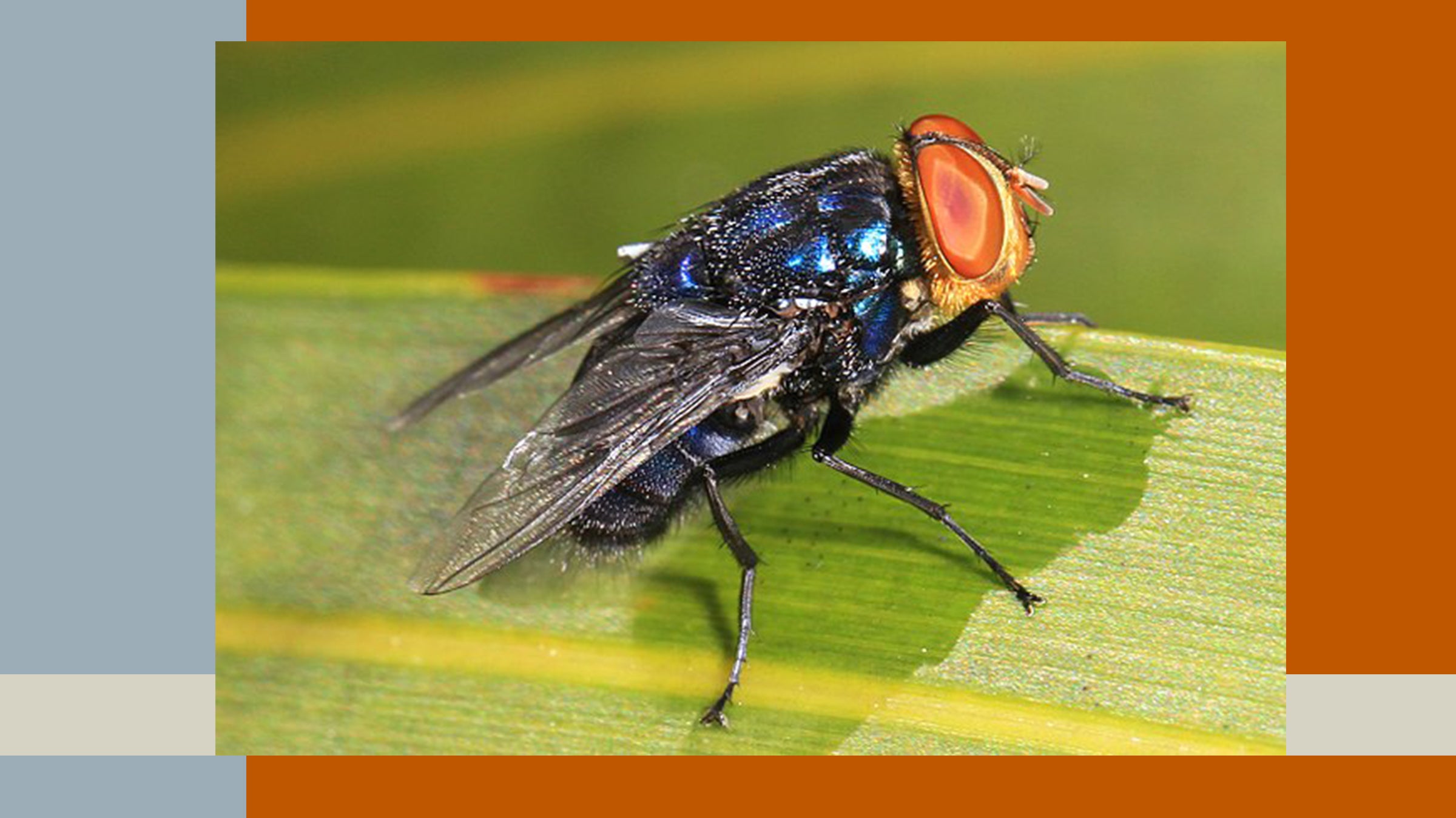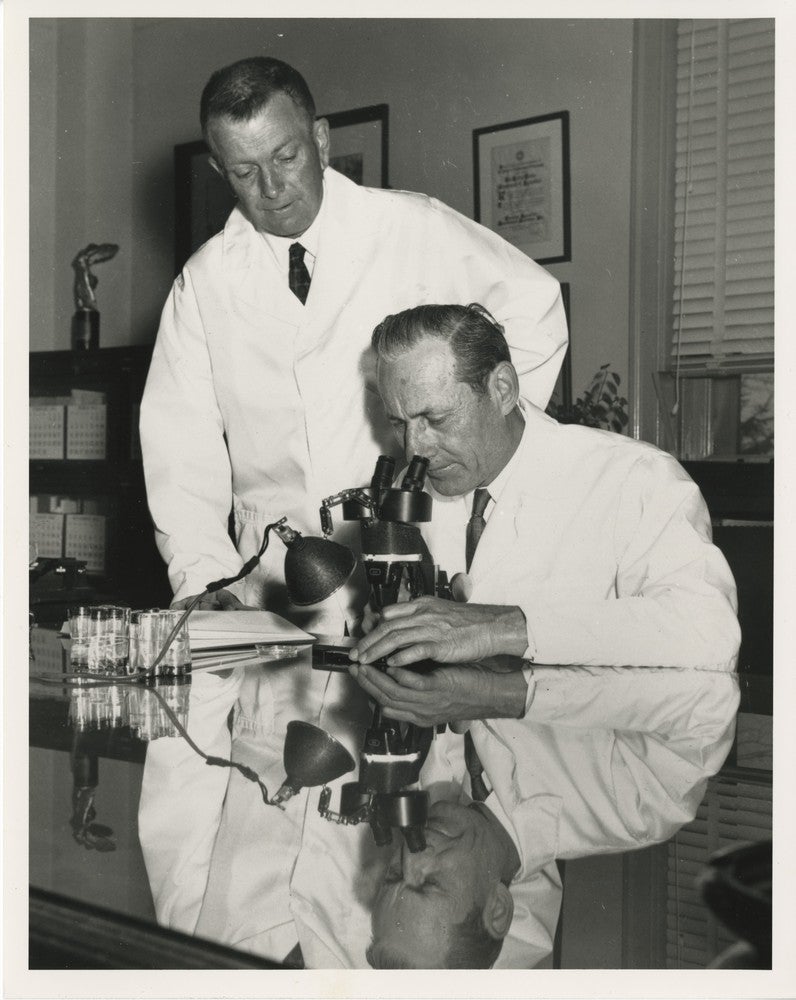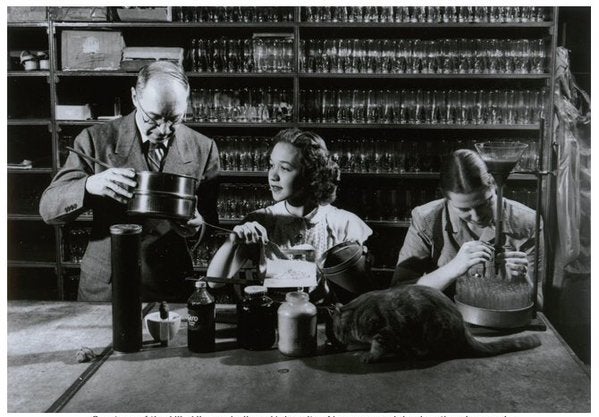
Few people want to be a screwworm fly (Cochliomyia hominivorax) for Halloween, but maybe this should be a valid costume choice as what they do is pretty horrifying. In the early to mid-20th century, this obligate parasite, often called just “screwworm” for short, was causing havoc and significant economic damage to livestock. In this fourth installment of the History of UT Entomology, we will be looking at this parasite and the eradication program to control it. It turns out that much of the UT research Hermann Muller did with the fruit fly, Drosophila melanogaster, had a direct impact on the two scientists who made the breakthrough in eradicating the screwworm.
But first, let’s go back in time a bit, to the early 20th century. Imagine you are employed as a ranch hand in any one of warmer regions of the US. Arguably the most important part of your job is to “doctor wormies” day and night. This is because female screwworms lay eggs in open wounds on livestock, as well as the naval cavities of their young. The eggs hatch into larvae that begin to feed on the flesh and body fluids of the animal. The wound will become infested and seep, attracting other screwworm flies to lay eggs. The result is a complicated infection that can kill the host in a relatively short matter of time. Livestock weren’t the only animals these pests infected. The screwworms also brought down wildlife like deer, squirrels, pets, and rarely a human.

Unknown. 1950s. “Dr. Edward F. Knipling (seated) and Dr. Raymond C. Bushland in laboratory.” Special Collections, USDA National Agricultural Library. Accessed November 24, 2020, http://www.nal.usda.gov/exhibits/speccoll/items/show/12348.
As livestock ranching expanded across the US, so did the screwworm problem. By the 1950s, the devastation to livestock ranchers was around $200 million a year, which is about $1.8 billion today. However, two entomologists, Edward F. Knipling and Raymond C. Bushland, led pioneering research starting in the 1930s, research that would eventually bring this parasite under control, and it was largely inspired by work Hermann Muller had done at UT during the 1920s.
THE STERILE INSECT TECHNIQUE
In the late 1930s, Knipling and Bushland had become collaborators, working at a USDA research station in Menard, Texas. Here, they would observe and perform experiments on the screwworm flies. Knipling observed that the female mated once for her entire life. Males were different, however, and mated as much as the opportunity presented itself. These two entomologists imagined that if there were a way to make males sterile, then the female fly would possibly mate with this infertile male, and her one mating opportunity would thus produce no offspring. The researchers coined this hypothetical method as the “sterile insect technique.”
At the time when Knipling and Bushland proposed this idea, their colleagues considered it very far-fetched. Word is that some laughed, making comments like “You can’t just castrate enough flies.”
Along came World War II, and Knipling and Bushland became preoccupied with researching diseases like Typhus that afflicted troops. But the screwworm didn’t care about human wars, and continued to cause headaches for livestock ranchers. The sterile insect technique would stay dormant for about a decade. However, sometime after the war, Knipling and Bushland returned to the screwworm problem and attempted chemical sterilization, but without success.
Enter Nobel Laureate Hermann Muller. In part two of our series, we looked at the genetics research Muller and colleagues did at UT from 1920-1932 with the fruit fly, Drosophila melanogaster. Muller reported results in 1927 which showed that mutations of genic material can be induced in Drosophila by exposing them to x-rays. After the horrors of World War II and seeing first-hand the effects of radiation, Muller was very vocal about the danger of its abuse and nuclear war. Knipling read a paper by Muller in 1950 in which Muller expressed these views, and in it, he referenced his earlier work that showed excessive amounts of radiation made fruit flies sterile.

Muller with staff and a cat in the Fly Room at Indiana University (Photo: Lilly Library, Indiana University)
Knipling wrote to Muller, who was then teaching at Indiana University, and described the sterile insect technique to which Muller replied that the theory was sound. Knipling and Bushland wasted no time, found an army hospital x-ray machine and used it on some male screwworm flies. They experimented with different radiation levels and developmental stages as they had to be careful. They couldn’t damage the flies enough to not attract mates. They eventually found the right formula: irradiate between 5.5 to 5.7 days into the pupal stage of the fly. This was when the adult fly’s ovaries and testes were developing and would be the most sensitive to radiation. It worked, without altering the fly’s normal mating instincts.
The efforts following this expanded in scope. They needed a secluded area in the real world where they could control the factors of their experiment. Failure initially found them when running tests on a small Florida island, until they realized the island’s fly population was being infiltrated by flies from the mainland. They needed a more secluded area. They found this place in Curaçao, a small island in the Caribbean that had seen their goat populations decimated by the screwworm. The experiment worked and eradicated the fly from the island.
The sterile insect technique then moved to the US in 1955. By 1966, U.S. officials had created a “barrier” against the screwworms, and declared them “eradicated” from the US. The following 40 years would see this program implemented through Central America into Panama. However straightforward as this sounds, there were a lot of hiccups that would make premature this initial 1966 declaration of being fly-free.
RICHARD H. RICHARDSON
Richard. H. Richardson (1938-2018), UT Professor, became involved in researching the eradication program in the 1970s. He was well suited for this as his later research focused on interactions between environment, economics, and agriculture, particularly management of rangeland and prairies. Richardson also came from a ranching family in Mexia, Texas, and would later be a ranchman himself. Undoubtedly, he would have seen screwworm devastation as a boy

Before Richardson became involved, southwestern states like New Mexico and Texas began to push for an eradication program in 1960. Mission, Texas became the sight of a new plant that produced around 200 millions sterile flies a week. Four years later in 1964, the USDA declared screwworms to be eradicated from Texas.
However, using the term “eradicated” was problematic. Reinvasions would happen all the time. In the 1970s, screwworms would continue to be an ongoing issue, albeit not at the scale it was in the 1950s. Still, Richardson felt the declaration of victory neglected the potential of other strains or species of screwworms moving out of Mexico into other regions. So in 1978, Richardson and colleagues would get involved. Previously, Richardson had been studying cryptic species of Drosophila and suspected there were also cryptic screwworm species. In biology, cryptic refers to a group of species that are very difficult to distinguish from one another. He addressed his concerns in a book titled The Screwworm Problem: Evolution of Resistance to Biological Control. Fortunately, many of the concerns Richardson posited have not materialized, but the analysis of potential problems of the eradication program were nonetheless important contributions, relevant to many genetic approaches to pest eradication.
Today, there is a “barrier” maintained in Panama through a joint commission of Panama’s agricultural department and the USDA, known as COPEG. The modern plant, located about 20 miles east of the capital on an old sugarcane plantation, breeds 2 billion flies per year, and prevents reinfestation from wild flies from South America. It’s a remarkable testament to the power of cooperation between countries, a cooperation that saves American farmers alone $1.3 billion, and a cooperation that must look beyond politics to science.
Thanks to David Hillis for his edits on this piece.
Check out all of our UT Entomology History blogs here…
SOURCES
“The Sex Life of the Screwworm Fly,” The Golden Goose Award, 2016. (accessed online: https://www.goldengooseaward.org/01awardees/screwworms)
“Richard Harvey Richardson, 1938-2018” Austin American Statesman Obituaries (accessed online: https://www.legacy.com/obituaries/statesman/obituary.aspx?n=richard-harvey-richardson&pid=188873002)
Zhang, Sarah. “America’s Never-Ending Battle Against Flesh-Eating Worms.” The Atlantic, May 26, 2020. (accessed online: https://www.theatlantic.com/science/archive/2020/05/flesh-eating-worms-disease-containment-america-panama/611026/)
Zoology Journal, The University of Texas at Austin. Pg. 3. Spring 1983.



